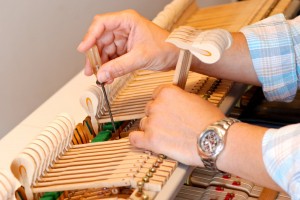Regulation of the piano action is the adjusting of the mechanical parts (engine) of the instrument. A perfectly regulated action makes the piano play and respond better to the players touch. Pianos need regulation to compensate for the effects of wear, the compacting and settling of cloth, felt, and buckskin, as well as dimensional changes in wood and wool parts due to changes in humidity and ageing. The action is the mechanical part of the piano that transfers the motion of the fingers on the keys to the hammers that strike the strings. It is comprised of over 9,000 parts which require adjustment to respond to a pianist’s every command, giving the player full control of his/her expression. All upright and grand pianos need periodic regulation to perform their best however the frequency of regulation is dependent upon amount of use, exposure to climatic changes, and the instrument’s quality, age and condition. Performance instruments may require some regulation before each use, due to the higher demands placed on them.
wear, the compacting and settling of cloth, felt, and buckskin, as well as dimensional changes in wood and wool parts due to changes in humidity and ageing. The action is the mechanical part of the piano that transfers the motion of the fingers on the keys to the hammers that strike the strings. It is comprised of over 9,000 parts which require adjustment to respond to a pianist’s every command, giving the player full control of his/her expression. All upright and grand pianos need periodic regulation to perform their best however the frequency of regulation is dependent upon amount of use, exposure to climatic changes, and the instrument’s quality, age and condition. Performance instruments may require some regulation before each use, due to the higher demands placed on them.



